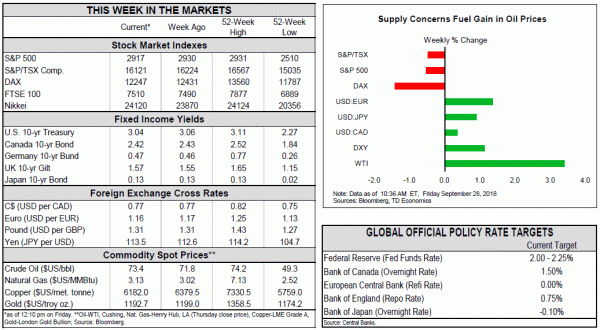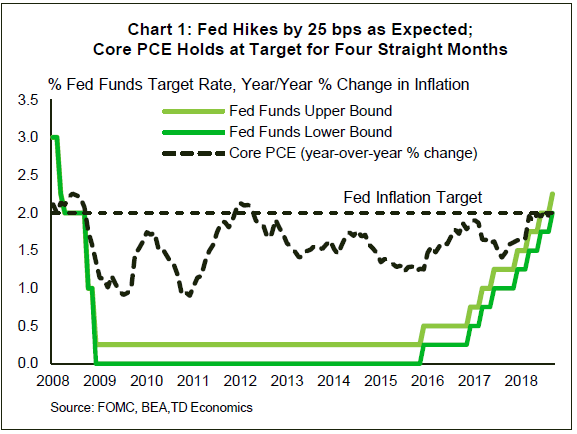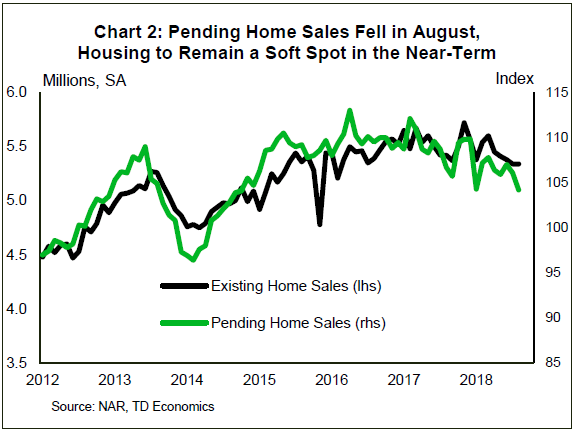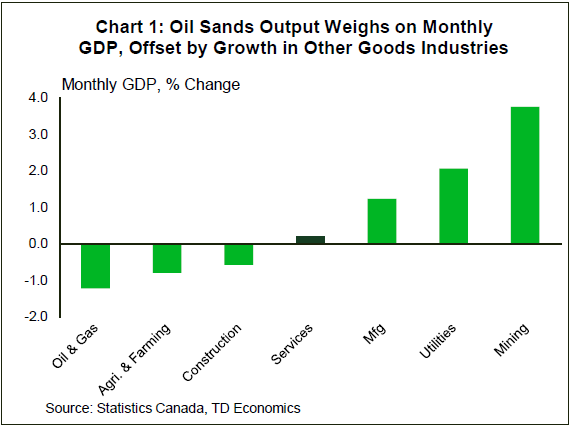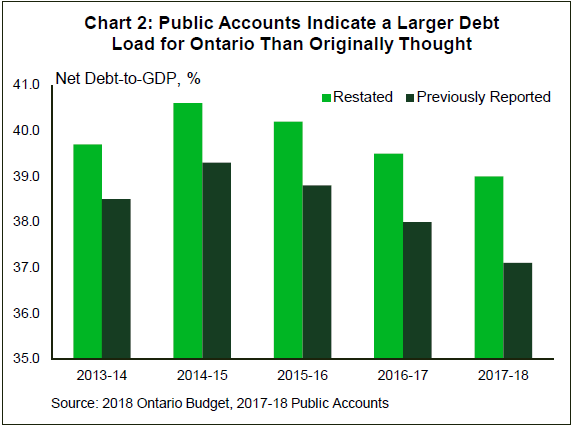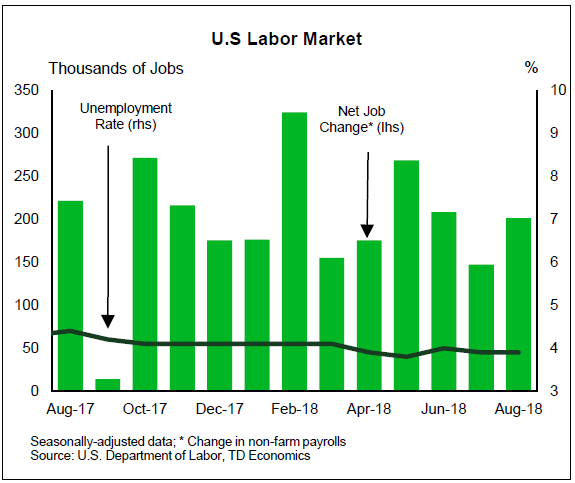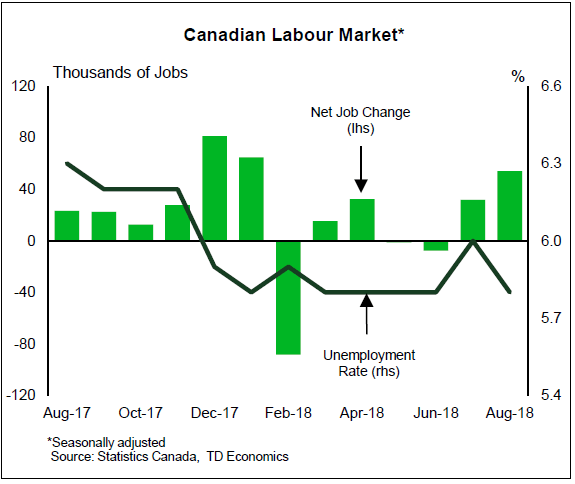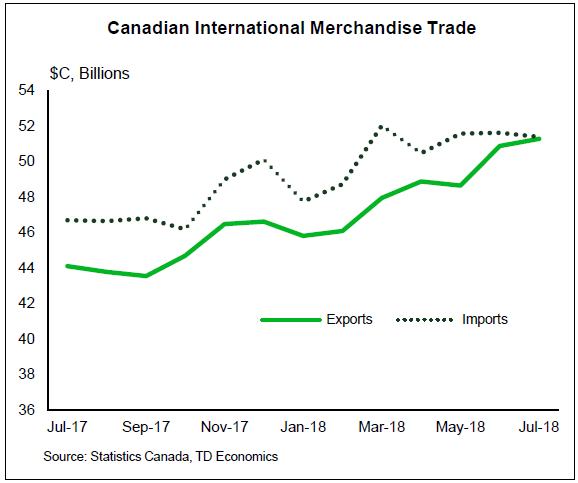The Weekly Bottom Line
U.S. Highlights
- The Fed hiked rates by 25 bps this week as widely expected. But, the communiqué dropped the reference to policy remaining “accommodative”. Interpretations regarding this change led to volatility in bond yields and equities.
- The debate on textual changes in the Fed statement detracts from the main point: the Fed remains committed to additional tightening – a message echoed by a broadly-unchanged rising interest rate path in the Fed dot plot.
- Despite not being all positive, economic data reaffirmed the notion that the U.S. economy remains on solid footing. Of note, real personal spending rose 0.2% in August, keeping our tracking for Q3 consumption above 3% (ann.).
Canadian Highlights
- GDP posted a trend-like 0.2% monthly gain in July on higher goods and services output. The decent monthly gain supports our above-consensus 2.4% call for third quarter growth.
- Last Friday’s release of the 2017-18 public accounts painted a worse picture of Ontario’s fiscal situation than previously thought and sets the stage for further spending cuts.
- New Brunswick elected a (very slim) conservative minority government on Monday, perhaps making it tougher to push legislation through government. Quebec’s provincial election is slated for next Monday. The incumbent Liberals and the poll-leading CAQ Party encouragingly share a commitment to reducing the province’s outsized debt.
U.S. – Don’t Let Textual Changes Get in the Way of Rate Hikes
The September FOMC meeting was the highlight of this week’s economic calendar. The Fed did not disappoint, hiking the Fed Funds rate by 25 bps as widely expected. This lifted the upper bound target to 2¼ % – the highest level since 2008 (Chart 1). The policy path ahead remained broadly unchanged as per the Fed dot plot. What’s more, the funds rate is now projected to remain above the longer-run neutral level through 2021.
Market focus however, gravitated more toward what was not in the Fed statement, rather than what was in it. The communiqué dropped the reference to policy remaining “accommodative”. This received a dovish interpretation initially under the premise that the Fed may be getting close to the end of the hiking cycle, leading to volatility in bond yields and equities.
The debate around textual changes in the Fed communiqué appears to detract from the main point – the Fed remains committed to further gradual tightening given its conviction for well-anchored inflation expectations and a positive view of the economy. Economic data in the week remained broadly in line with this narrative. The Fed’s preferred measure of inflation held right on target for the fourth straight month in August. Meanwhile, real personal spending was up 0.2% in the same month. While this marks a slight moderation in the monthly pace of spending, it’s sufficient to keep our tracking for third quarter consumption growth north of 3% annualized. A solid rise in wholesale and retail inventories added to the positive tally.
Not all of the data was positive though, with soft pockets including trade and housing. The goods trade deficit widened more than expected in August. The first two months of the quarter reaffirm the notion that, unlike the second-quarter experience, net trade will be a drag on growth this time around. Pending home sales, a leading indicator of sales activity, also fell 1.8% in August (Chart 2). This marks the fourth decline in five months, suggesting that sales will continue to languish in the near-term.
Putting all the pieces together, the economy is still on solid footing, with over 3% growth expected in the third quarter. With price pressures holding near target, this should indeed be sufficient for one more hike before the end of the year. Beyond this point, however, there is significantly more uncertainty, as trade disputes pose significant downside risk to the economic outlook.
The U.S.-China trade conflict saga continued to play out in the background, given other more salacious domestic political developments. China scrapped talks with the U.S. as tariffs on $200 bn of Chinese goods came into effect. Meanwhile, President Trump accused China of attempting to interfere in the upcoming midterm elections, given his stance on trade. With the two economic heavy-weights on a hard-to-avoid collision course, we see this dispute as a key risk to growth. Tariffs in effect and those threatened could knock off up to 1 p.p. from U.S. and 0.3 p.p. from global economic growth (see here).
Canada – Provincial Developments Take Centre Stage
Global oil prices drifted higher again this week on signals that OPEC and Russia had no immediate plans to raise production, despite looming U.S. sanctions on Iranian oil exports. However, the story for Canadian producers remains one of weakness, given the persistently large wedge between WTI and Western Canada Select (WCS) prices. Meanwhile, precious little progress was made this week on NAFTA negotiations, with President Trump claiming to have spurned a trade meeting with Prime Minister Trudeau, casting a pall on the mood.
On the economic data front, last week’s flood of releases turned into a slow drip. The most notable report – July’s monthly GDP data – showed a decent 0.2% monthly gain. Goods output advanced 0.3%, lifted by manufacturing, mining and utilities production. However, oil and gas sector output was down significantly, weighed on by a power outage at the Syncrude facility in late June (Chart 1). Meanwhile, services-sector output advanced 0.2% in July, proving once again its status as stalwart of the Canadian economy. All told, July’s data reinforced our above-consensus 2.4% call for third quarter growth.
With a quieter week on the economic calendar, provincial political and fiscal developments came increasingly into focus. Last Friday, the 2017-18 public accounts for Ontario were released. What is typically seen as a ho-hum affair was anything but, with the accounts offering a new look at the province’s restated fiscal position following audits ordered by the PC government. As expected, the accounts painted a worse picture of Ontario’s fiscal standing than originally reported (Chart 2). Indeed, in a speech on the same day of the release, Finance Minister Fedeli reported a $15 billion shortfall for this fiscal year, versus the $6.7 billion deficit projected by the prior government. While a $15 billion deficit is nothing to sneeze at, prior analysis by the Auditor General and the Financial Accountability Office had already prompted markets to expect something big, reducing the sticker shock from the announcement. Ultimately, larger deficits set the stage for the government to deliver additional spending cuts, which could offset benefits to growth from promised tax relief.
Not to be outdone, New Brunswick held its own provincial election on Monday, producing a (very slim) victory for the new minority Conservative government. While we await an updated budget to inform our forecasts, election of a slim minority will likely make it tough to push policies through government, at least not without some compromises.
Looking ahead to the coming week, a provincial election in Quebec is on tap for Monday. Current polling points to the Coalition Avenir Quebec (CAQ) holding an advantage over the incumbent Liberal Party. In terms of policy, the parties seem somewhat aligned on a few points, with arguably the most important being their shared commitment towards reducing Quebec’s mountainous debt load. This should appease credit rating agencies and help shore up business confidence.
U.S.: Upcoming Key Economic Releases
U.S. Employment – September
- Release Date: October 5, 2018
- Previous: 201k, unemployment rate: 3.9%
- TD Forecast: 180k, unemployment rate: 3.8%
- Consensus: 188k, unemployment rate: 3.8%
We expect payrolls to rise by a solid 180k in September albeit a touch softer than in August (201k). Manufacturing should make a comeback, offset by some deceleration in private services. ISM and regional surveys suggest an overall solid figure near 200k, though September prints tend to disappoint expectations and see upward revisions. Hurricane Florence should not impact the payroll figures, as persons in the survey are counted as employed if they worked or received pay for at least one day of the pay period (that includes the 12th of the month). Evacuations did not begin until the 10th to 11th, so it is plausible that workers would still be considered employed.
Wages however could see an impact. The hurricane should negatively impact hours worked, implying a boost to average hourly earnings. Reference week itself (with the 12th landing on a Wednesday) also suggests a strong read, with m/m increases averaging 0.3% and up to 0.5%. We therefore expect a 0.3% m/m print, with upside risk for 0.4% and leading the y/y pace lower to 2.8%. Note that revisions could bias the y/y pace lower, as strong readings (such as the 2.9% rate in August) tend to be revised away.
Finally, we expect the unemployment rate to dip further back to its previous low of 3.8% on the back of strong jobs gains, though a pickup in participation is an upside risk.
Canada: Upcoming Key Economic Releases
Canadian Employment – September
Release Date: October 5, 2018
Previous: -52k, unemployment rate: 6.0%
TD Forecast: 25k, unemployment rate: 5.9%
Consensus: N/A
TD looks for the September employment report to show job growth of 25k for the month, although the details should prove less upbeat than the headline print. Part time employment should rebound after registering the second largest decline on record, which will leave full-time employment down slightly on the month. We also look for employment gains in retail trade, construction and professional services after suffering outsized declines in August. Job growth of 25k alongside a more modest inflow to the labour force should allow the unemployment rate to edge lower to 5.9%, leaving it contained within the recent range, while wage growth for permanent employees is expected to slip to 2.4% y/y. If realized this would mark the fourth consecutive deceleration since the 3.9% highs in May, which accompanies a similar pullback in SEPH wage growth.
Canadian International Trade – August
Release Date: October 5, 2018
Previous: -$0.1bn
TD Forecast: -$0.5bn
Consensus: N/A
The international trade deficit is forecast to widen to $500m in August on a decline in both export and import activity. Weakness in the former will be concentrated in energy products, where we look for a significant pullback on the heels of disruptions to production and lower crude oil prices. Motor vehicles will provide a key offset as presaged by US import data which should leave non-energy exports unchanged on the month after accounting for a broad decline in factory prices. Imports should see a modest decline, although after two months of little growth we expect any further pullback to be modest. Meanwhile, real exports should outperform the nominal print on the 0.5% decline in factory prices and an even more significant decline in raw material prices, which suggests the drag on growth will be more modest than the headline print would imply.




